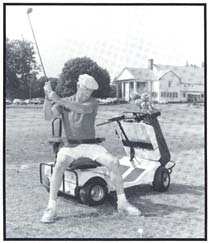
Photo provided by Electric Mobility Corporation
|
A leisure or sport option for some, golf played by individuals with disabilities may be a hazardous undertaking. Because of this circumstance, these individuals may be denied the opportunity to play by a golf course superintendent. For example, approaching a teeing area that is elevated on a hill may be cumbersome for a person using crutches or virtually impossible for someone in a wheelchair. A golf cart path to a putting green may be too narrow, thus rendering it inaccessible to a wheel-. chair user. Wheelchairs and other assistive devices may severely impact putting greens (The Wall Street Journal, August 29, 1995).
Disputes over design and policy issues pertaining to golf course accessibility have led to legal confrontations. Golfers with disabilities are now filing formal complaints with the U.S. Department of Justice against golf courses to which they were allegedly denied the right to set a crutch or use a wheelchair on the course.
A fundamental premise of the game, however, is to play the course as one finds it-to play the ball as it lies. The endless variety of individual golf courses adds much to the charm, interest, and uniqueness of the sport. Thus, the layout of a course provides a significant element of challenge to the sport. The game was never intended to be fair (Recreation Report, U.S. Access Board, July, 1994).
With the passage of the Americans with Disabilities Act (1990), the United States Architectural and Transportation Barriers Compliance Board (Access Board) was charged by the Department of Justice in 1993 to create architectural guidelines to address issues regarding access to new and existing golf courses. Advocates of these guidelines do not intend to require golf courses to resemble airport runways-flat as a pancake. "Access rules are intended to provide greater liberty to individuals with disabilities while maintaining the integrity of the course landscape," according to Greg Jones, President of the Association of Disabled American Golfers.
Accessibility guidelines developed by the Access Board's Golf Subcommittee currently recommend that at least one teeing area on each hole and at least one route to all putting greens be accessible. To maintain the game's integrity, sand bunkers and water hazards do not have to be made accessible.
A major concern of the new accessibility guidelines focuses on the amount of damage, if any, wheelchairs and assistive devices may cause sensitive turf grass areas, especially putting greens. The Golf Course Superintendents' Association of America discourages the use of wheelchairs and other untested equipment that could damage a green. However, golfers with disabilities will often scuttle across the green using hands, knees, or whatever it takes to make a putt.
The United States Golf Association is currently funding Rutgers University to study the ability of putting surfaces to withstand damage from wheelchairs, assistive devices, and foot traffic. The study will enable golf course superintendents to assess and potentially alter management practices that influence the bearing strength of putting greens.
Recent technological improvements are enabling golfers with specially designed golf carts (i.e., with modified tires) to access putting greens. If engineered correctly, golf carts will do no more damage to a green than mowers used to cut the grass on a golf course.
What is in doubt is whether golf courses should be required to supply these specially designed golf carts to golfers with disabilities. Attorneys for the Department of Justice have indicated that if it is ruled that a golf cart is considered an auxiliary aid rather than a personal assistance device and if a golf course provides golf carts for the general population, then the club may have the responsibility to provide golf carts with adaptive devices for golfers with disabilities.
Another major question, then, is what adapted devices would/should the golf course be required to provide on golf carts (e.g., hand controls, swivel seat, grab bars, etc.). At present, there is no body of knowledge on the types of adaptations that golfers with disabilities might require to both safely and successfully operate a golf cart (Recreation Report, Access Board, July, 1994).
"Individuals with disabilities are just beginning to realize the opportunities existing for them in the game of golf," according to Dr. Gary Robb, Director of Indiana University's National Center on Accessibility. The golf industry can view golfers with disabilities as potential problems or a new marketing niche. Hopefully, as federal regulations are approved and more local design and policy issues resolved, the industry will see this population as a great opportunity to advance the game of golf.